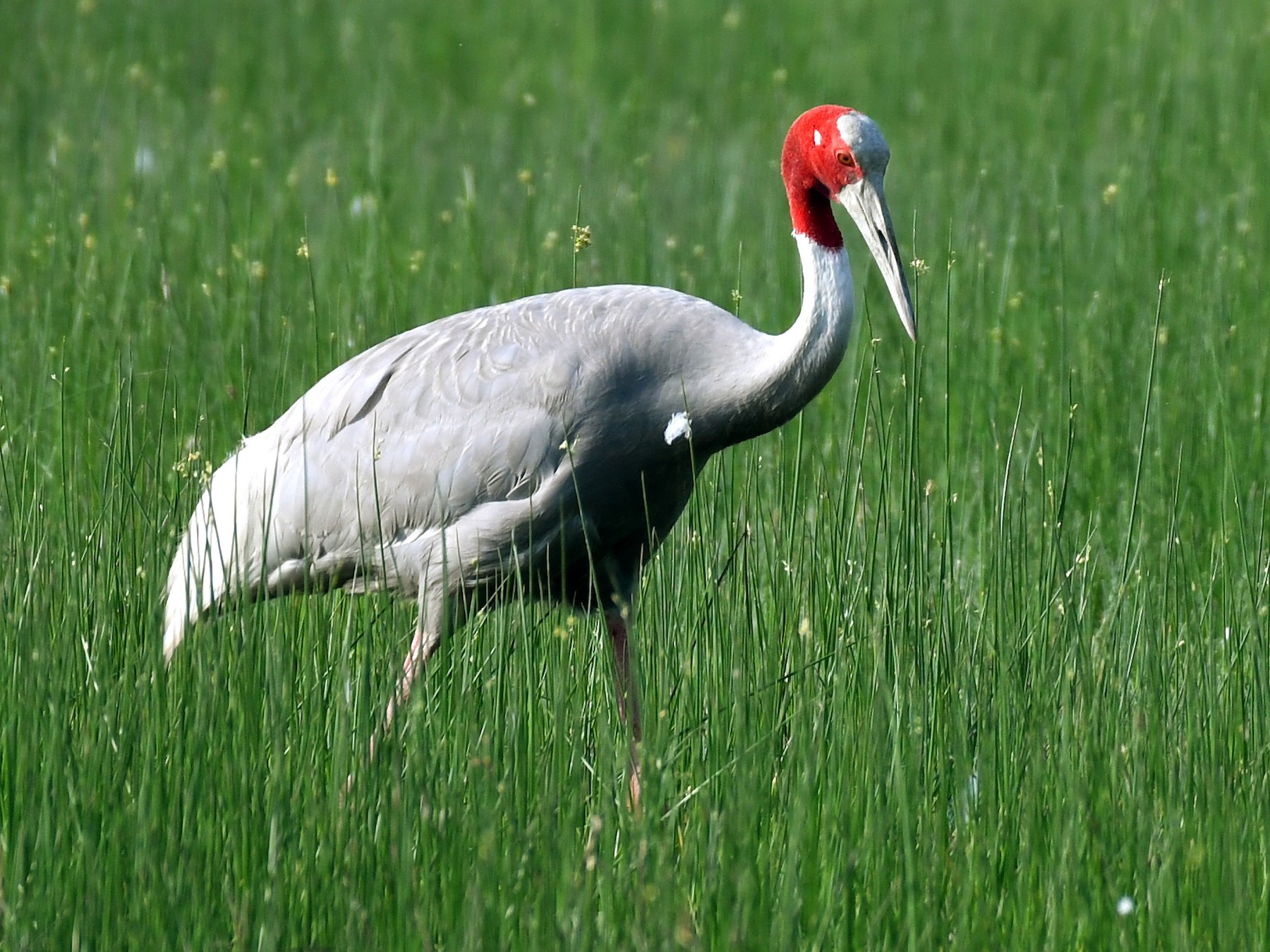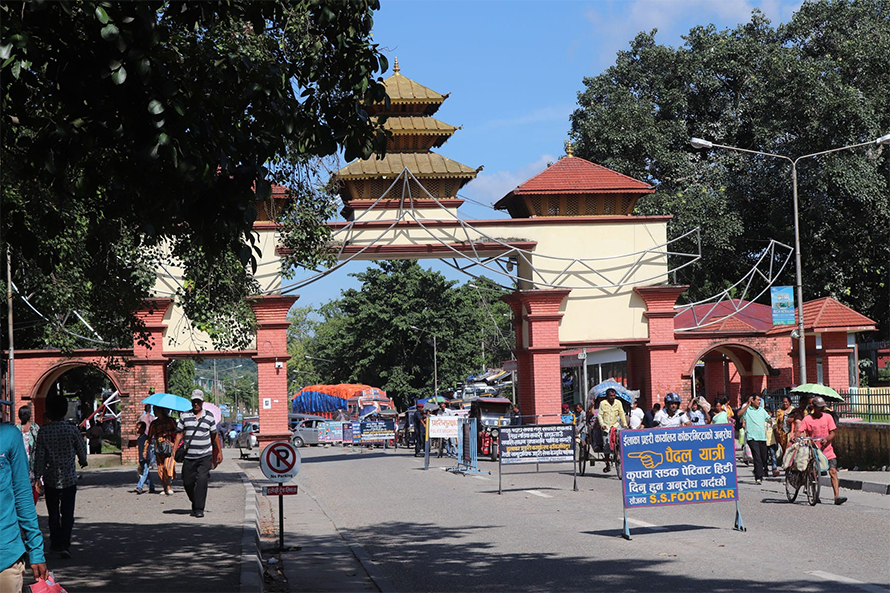Buddha’s bird, the Sarus crane, facing an existential threat
 NepalPress
NepalPress

LUMBINI: Participating conservationists and guests put their hands together when the bird festival organised by the Lumbini Development Trust (LDT) on 26 November 2018 declared the Sarus crane (Grus antigone) as ‘city bird’ of Lumbini.
The world’s tallest flying bird species has found its historical and spiritual significance in epic Ramayana and a story surrounding Siddhartha Gautam Buddha.
But, the non-migratory birds have faced existential threat due to factors like their collision with electricity lines, increasing urbanisation, noise and industrial pollution, hunting, rampant use of pesticides and human activities, and largely due to encroachment on their habitats.
Arjun Kurmi, chairperson of Green Youth, Lumbini, a local club working for the conservation of birds, said the bird species were increasingly disappearing.
Earlier, more than two dozen pairs of the bird were spotted outside the eastern wall of the LDT building.
But, they disappeared in the past few years, he said.
Seven pairs of the bird species reared in the wetland area of Lumbini Village in the northern part of the LDT also vanished, he said.
He added that they were forced to move elsewhere to lay and hatch eggs as their habitats–lakes, streams, wetlands and farmlands at Bharthapur, Bhujahiya and Aama of Lumbini Sanskritik Municipality, Betkuiya and Pharena of Sammarimai Rural Municipality and Bogadiya of Kotahimai Rural Municipality–get dried during the dry season.
Drying up wetlands during summer has also affected the breeding of the bird. The sarus cranes are mostly found in parts of the Indian subcontinent, Southeast Asia and Australia.
In 2000, they were enlisted in the IUCN red list of threatened species. Similarly, the National Parks and Wildlife Conservation Act, 1973 has enlisted sarus crane as a protected bird.
In Nepal, killing a sarus crane is punishable by Rs 15,000 to Rs 30,000 in fine per person or three to nine months imprisonment or both, according to the Act.
The world’s tallest flying bird stands 152-156 cms tall with a wingspan of 240 cms. It weighs 6.8-7.8 kilograms.
They are a social creature, found mostly in pairs or small groups of three or four. Nests are built on water in natural wetlands or in flooded farmlands.
According to ornithologist Hiru Lal Dagaura, it lays two eggs. After laying eggs, both the male and female protect them alternately.
The chicks live with their parents for six months, and thereafter they live in pairs.
The chicks hatch at an interval of around 30 to 32 days. In Nepal, they are mostly found in Kapilvastu, Banke, Dang and Chitwan; Kalikich lake and the buffer zone, Beldandi of the Shuklaphanta National Park in Kanchanpur.
However, their numbers have been on the decline. According to a study carried out in March, 2022 by the Himalayan Nature, a development and conservation research institute, their number in Rupandehi and Kapilvastu was 354 as opposed to 394 in 2021 and 404 in 2020.
The institute works for sustainable livelihoods of Himalayan communities as initiating scientific research on Himalayan biodiversity and the broader environment.
“In the past, the bird species in hordes could be easily spotted at a single place. They are fond of living in pairs wondered in farmlands. But, these sights are rare nowadays,” observed a local media-person Anjana Chauhan.
Increasing urbanisation has posed threats to it, she argued. Dr Sudip Subedi, programme director for the Himalayan Nature admitted to declining bird species.
Rampant use of pesticides, unmanaged urbanization and hunting among others are main threats to them, he said.
“Excessive use of pesticides in farmlands is detrimental to their reproduction.”
The bird species help with crops as they feast on insects, he said. In general, they hatch eggs during mid-June and mid-August.
“They build nests in paddy fields where long-stemmed rice plants are grown. However, lately, people left planting long-stemmed rice saplings, thus destroying their habitats,” he said.
Live electric wires and stray dogs are major threats to them. In the past five years, seven sarus cranes were electrocuted on the edge of Aamagaun in the municipality-12, said Kailash Jayaswal of the Nature Conservation Foundation.
“Many sarus cranes died in the municipality area from collusion with power lines during winter in particular. The average mortality rate was six pairs of the bird every year,” he said.
In the first week of August, 2020, two pairs died after being electrocuted in the southern border of Tarakulaha village in the municipality-6, he said.
Insulating electric wires through various means like putting reflectors and a layer of plastic are among ways to save the birds, he suggested.
According to a school teacher Hari Mohan Chaudhary, the bird is a symbol of love and devotion.
They live in pairs; in case of death of their spouse, it lives alone throughout its life without getting married again or it even sacrifices its life in mourning.
The bird holds spiritual significance connection with Gautam Buddha. According to sayings, prince Siddhartha, many years before he would become Buddha after getting enlightenment, saved a wounded sarus crane.
The bird got wounded by an arrow shot by his cousin Devadatta.
Later, a dispute arose between Siddhartha and Devadatta over who the wounded bird belonged to.
The matter, eventually, landed in the court of King Suddhodhan, father of Siddhartha, and the king gave the verdict that the wounded bird belonged to Siddhartha–the one who nurtured and saved it, but not the one; who tried to kill it.
The bird is also associated with the Ramayana. The epic’s composer Valmiki was inspired–by separation of a couple of sarus crane–to write its verses.
The opening of the Ramayana is believed to be based on the separation of a couple of the bird,” said Tribhuvan Barai, a lecturer at Tribhuvan University.
A spouse of a bird couple, while making love, was shot dead by an arrow by a hunter along the banks of the Tamasa river.
The bird struck by separation with its spouse killed itself. After seeing the tragic story of the couple of the bird, a sage cursed the hunter, and the opening verses of the Ramayana are based on this curse.
After Siddhartha saved life of a wounded sarus crane, its presence grew in Lumbini, the birthplace of Gautam Buddha, it has been said.
“Sarus crane is Lord Buddha’s bird. It is our duty to save it,” said right activist and civil society leader of Kapilvastu Ram Dayal Thakur.
The birds also hold a special relationship with the farmers of Lumbini. The presence of the birds is believed to be the indicative of healthy wetlands—favourite habitat for them—meaning for the production of good crops.
Lumbini has also honoured the bird by declaring it as ‘city bird’ On the occasion of the bird festival, the then mayor of the Lumbini Sanskritik Municipality, Manamohan Chaudhary, said, “There is a special relation between Lord Buddha and sarus. So, we announced it as ‘city bird’.”
In the country, the number of the bird was around 300—out of which Lumbini alone had 250–according to Bhupal Nepali, the project officer for the Nepal Bird Conservation Association.
In a bid to protect the birds, the sarus protection campaign has been in place since 1994 in collaboration between the LDT and the Crane Foundation.
After reaching an agreement with the LDT (December 25, 1994), the International Crane Foundation has established the Lumbini sarus reserve in a bid to conserve the birds—for which it has leased 256 acre land (153 bigha) in the Lumbini village out of 1,155 bigha allocated to conserve sarus crane bird species.
Dagaura also blamed habitat losses primarily caused by a destruction of wetlands, and a lack of their prey for their decreasing number.
The birds are found mostly in Nepal, Australia, Cambodia, China, India, Laos, Myanmar, Pakistan and Vietnam, according to ornithologists. Out of 15 bird species in the globe, four are found in Nepal. RSS














